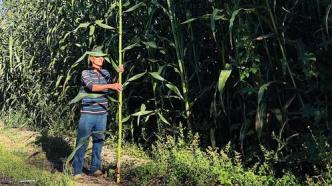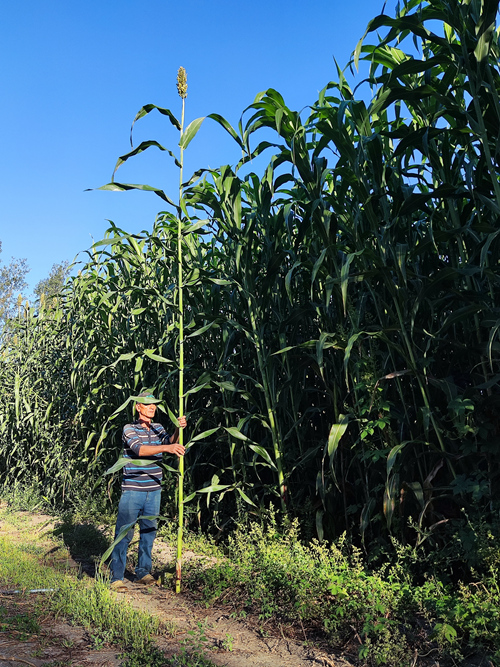
·Researchers predict that if 20% of the world's saline-alkali lands use the research results related to the saline-alkali tolerance gene AT1/GS3, at least 250 million tons of grain can be increased each year.
·Natural mutants of the GS3 gene have been found in rice, without even gene editing.
Can saline-alkali land grow food?

On September 6, 2022, the scientific research team tested the production of Zhongketian 968 variety in Fangshan District, Beijing. The plant height of this sorghum variety is 4.35 meters. Photo courtesy of Xie Qi, a researcher at the Institute of Genetics and Developmental Biology, Chinese Academy of Sciences
"My hometown is Jiangsu, and there is sweet sorghum, which we eat as sweet stalks. We knew about it when we were five or six years old," said Xie Qi, a researcher at the Institute of Genetics and Development, Chinese Academy of Sciences.
He must have never imagined that decades later, he would discover a gene worth tens of thousands of dollars from sorghum.
Sorghum, which originated in the Sahel region of Africa with a dry and hot climate, has "sent" the first important salt-alkali tolerance gene AT1/GS3 to Chinese scientists after a long period of evolution and adaptation to the local environment.
10 scientific research institutes have jointly tackled key problems for many years, and published two important research papers in one day . After application, the world can increase grain production by at least 250 million tons per year. The above-mentioned important research results of Chinese scientists have aroused widespread concern and discussion.
On March 24, the day the paper went online, one of the corresponding authors, Xie Qi, a researcher at the Institute of Genetics and Development of the Chinese Academy of Sciences, told The Paper that he had received many interview calls, and WeChat could not reply.
Researcher Xie Qi told ThePaper that the newly published research results on salt-alkali tolerance genes have two major breakthroughs: one is a theoretical breakthrough, and no one knew before that it has the function of regulating the salt-alkaline tolerance of crops; the second is a breakthrough in application, At present, they have tested staple food crops including sorghum, rice, corn, and millet in field experiments, and they can significantly improve the salt and alkali tolerance, yield and biomass of these crops. It's more likely."
Will there be a second or third salt-alkali tolerance gene in the future?
Xie Qi said, "This is a start."
In the farmland, you need to drink four or five liters of water a day
Xie Qi said, "Our country is very large, but the distribution of water resources is uneven, and there are many saline-alkali lands." Agriculture is a major scientific issue that involves the country's food security. When he returned to work in China, he paid attention to the stress resistance of plants, but at that time he still used the model plant Arabidopsis to do research, published some papers, and was rated as one of the "highly cited" scientists, but he found many The results cannot be used directly. "The most saline-alkali-tolerant crop I found is sorghum."
In 2007, he began to conduct research on sorghum. "First, we collected local varieties from Nantong, Jiangsu. Later, he felt that the scope was too small, so he began to collect domestic and foreign varieties for research." Xie Qi said.
Xie Qi said, "In addition to doing experiments in the laboratory, we also have to go to the field. The saline-alkali land we are going to is a desolate place, and the staff are very hard. The sampling of sorghum fields is always in summer, July and August, and three days outdoors. Seventeen or eight degrees, in the field all day, drinking water will drink four to five liters of water."
Fortunately, their efforts were not in vain. On the morning of March 24, 2023, they collaborated with 10 research institutes including China Agricultural University, Huazhong Agricultural University, Institute of Biophysics, Chinese Academy of Sciences, Peking University Modern Agricultural Research Institute, Shandong University, Ningxia University, Northeast Institute of Geography, Chinese Academy of Sciences, and Yangzhou University. The research results of the salt-alkali tolerance gene AT1/GS3 that have been discovered and verified have been published online in the international academic journals "Science" and "National Science Review".
Rice, maize, sorghum and millet improved based on the salt-alkali tolerance allele AT1/GS3 all effectively increased the yield and biomass by about 20-30%.
According to the survey data of the Food and Agriculture Organization of the United Nations, as of 2015, more than 1 billion hectares of salinized soil in the world cannot be effectively used due to excessive salinity.
Researchers predict that if 20% of the world's saline-alkali lands use the above-mentioned gene-related research results, it can increase global food production by at least 250 million tons per year.
A discovery worth ten thousand dollars: Two breakthroughs have been achieved, and three domestic patents and one international patent have been applied for
Researcher Xie Qi told The Paper, "No one knew it had this function before, and this is a big breakthrough in theory."
Researcher Xie Qi explained that the AT1 protein, whose homologous gene in rice encodes the protein GS3, is actually a star protein, which was discovered in human genes in 1970 and in plants in 1990, "but No one knows that it is related to the alkali resistance of crops, nor what signaling pathway it regulates. We found that it excretes harmful ROS, that is, hydrogen peroxide molecules, which are harmful to cells, through the downstream aquaporin. to protect cells." "After phosphorylation of aquaporin, it can pump harmful ROS out of the body, and AT1 mainly inhibits the phosphorylation of aquaporin, so in fact, plants are more salt-alkali tolerant after AT1 knockout."
Salt and alkali are two different things. Xie Qi said that if there is salt, there is alkali. Of the 1 billion hectares of saline-alkali land in the world, 60% are alkaline, but there are very few research results in this area before, and no gene can be used to improve crop salt-alkali tolerance. "Through our research, it has been confirmed in the five major crops that AT1/GS3 can improve the salt-alkaline tolerance of the crops, and the yield will be high." "In some places, it is from dead to alive. That is to say, without modification (gene ), it (crop) will all die. In such a high salinity place, after the (gene) is modified, it can survive."
Another breakthrough is in applications. "This should be the first gene that has such a good application directly in crops." Xie Qi told The Paper that at present, they have cooperated with other scientific research institutions to complete the verification of crops such as sorghum, rice, wheat, corn and millet. . Through gene editing, the AT1/GS3 gene is knocked out, and the crops are highly resistant to salt and alkali. This kind of genetic improvement does not require the introduction of foreign genes. Relatively speaking, in terms of application, national approval and supervision, "it is easier than genetic modification." "Moreover, natural mutants of the GS3 gene have been found in rice, and even gene editing is difficult." No need to do it."
In terms of patents, Xie Qi said that the current patents are jointly applied by relevant scientific research units, including three Chinese patents, and an international PCT patent, so as to cover the relevant intellectual property rights globally. "Of course, more research is needed to confirm whether our results can be expanded to apply."
Implications of a genetically altered crop in saline-alkali land: basic research must be done very well
Xie Qi said that he believed that the study of salt-alkali tolerance genes brought at least two revelations. First of all, basic research must be done very well. Only when the basic scientific research is done well can the application be made wider in the future.
Second, in his opinion, be down-to-earth. "Agriculture can't be done by sitting in the office. You don't just have to go to the field to see, you have to go to different fields." It is a very important step." "So we actually publish a lot of articles now, but we rarely use them. This also needs our attention." Xie Qi said.
In the future research plan, Xie Qi said, first of all, the signaling pathway of crop alkali resistance should be made clearer, and only after the basic theory is completed can it be better used in production practice. Secondly, "Can we combine salt and alkali resistance? Weeds like reeds are more resistant to salt and alkali than our current crops, right? Can we create crops that are more resistant to salt and alkali, or It is a drought-tolerant and water-saving crop. This will be a direction of our applied research." Xie Qi said.
Will there be a second, third salt tolerance gene?
Xie Qi said that there are already some canidate (candidate genes) and they are continuing to study in depth. "This is a start."
The first author Zhang Huili: When encountering a bottleneck, the instructor once started to do experiments in person
Zhang Huili is one of the first authors of the above two papers. She enrolled in 2018 and studied for a doctorate in Xie Qi's laboratory. She has officially devoted herself to research on salt-alkali tolerance genes. She has graduated with a doctorate and started postdoctoral research.
Zhang Huili told The Paper that AT1 encodes the gamma subunit of the G protein, and the protein is not large, with a total length of only 198 amino acids. "It is a negative regulatory factor. After mutating it, the crops are more salt-tolerant."
Zhang Huili introduced that Teacher Xie aimed at the subject of saline-alkali resistance a long time ago and carried out related research. "The material accumulation before I came here is very important. Our research group has sorghum germplasm resources from different places." "We first discovered the AT1 gene through genome-wide association analysis, and then performed gene function verification, and found that AT1 is indeed A gene that negatively regulates alkali resistance. Through other molecular biology techniques, we found its interacting protein—aquaporin." Through gene editing, after the AT1 gene was mutated, the phosphorylation inhibition of aquaporin was released , after phosphorylation occurs, the hydrogen peroxide in the cell is pumped out, the cell survives, and the crop yield may increase.
Zhang Huili said that in 5 years, "(research progress) has been considered fast." "Other salt-alkali tolerance genes may follow."
Zhang Huili said that during the research process, there were too many unforgettable things. She said, "There are many times when the experiment cannot go on, our instructor will do it by himself. When encountering a bottleneck period, there is really no way to continue, and it is Teacher Xie who goes into battle in person." "For me, my luck is very good. Met a good mentor."